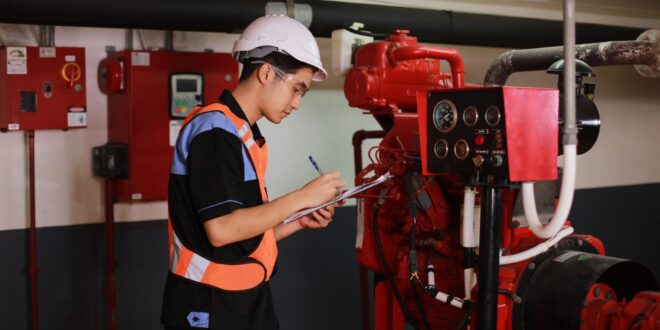In the intricate landscape of modern construction, fire engineers emerge as pivotal players, their expertise woven into the very fabric of building design and safety. As our urban environments grow taller and more complex, the stakes associated with fire safety have escalated dramatically.
Gone are the days when the presence of a fire extinguisher was seen as adequate preparation; today’s architects and developers rely heavily on fire engineers to craft comprehensive fire safety strategies that not only comply with stringent regulations but also anticipate potential hazards in innovative ways. From meticulously calculating the most effective egress routes to designing passive fire protection systems that can withstand the test of time, these professionals ensure that every structure not only meets legal standards but also provides a sanctuary for its occupants in times of crisis.
As we delve deeper into their multifaceted roles, we uncover a blend of science, artistry, and foresight that defines the essence of fire engineering in contemporary construction projects.
Fire Safety Regulations and Standards

Fire safety regulations and standards are fundamental to ensuring the protection of lives and properties in modern construction projects. These regulations, which vary by location but often align with international codes, dictate the minimum requirements for materials, methods, and design principles aimed at mitigating fire risks.
Fire engineers are tasked with navigating this complex landscape, interpreting these codes, and applying their insights to optimize building designs. For instance, they assess the flammability of materials, strategize effective evacuation routes, and incorporate robust fire detection and suppression systems.
As construction methodologies evolve and innovative materials emerge, staying abreast of regulatory changes becomes imperative. This dynamic interplay ensures that safety is not just a checkbox but an integral part of the architectural fabric—a commitment to resilience in the face of potential disaster.
Risk Assessment and Hazard Analysis

In the realm of modern construction, the role of fire engineers extends far beyond the mere installation of safety systems; it encompasses a critical phase of risk assessment and hazard analysis that lays the groundwork for robust fire safety measures. These professionals meticulously evaluate the unique characteristics of each project, diving deep into the intricacies of building materials, occupancy types, and architectural layouts.
This involves not only identifying potential fire hazards but also considering external factors like nearby structures and environmental influences that could exacerbate risk. Through advanced modeling techniques and simulations, fire engineers can predict how a fire may behave within the constructed space, enabling them to design effective mitigation strategies tailored to each scenario.
They collaborate closely with architects and builders, ensuring that fire safety measures are seamlessly integrated from the ground up, transforming theoretical assessments into practical solutions that protect lives and property alike. In an era where construction often pushes the boundaries of innovation, the foresight and expertise of fire engineers are indispensable, serving as both a shield and a guide through the complexities of fire safety in contemporary building practices.
Designing Fire Protection Systems

Designing fire protection systems requires a multifaceted approach that intertwines engineering principles with a keen understanding of safety standards. Fire engineers meticulously assess building layouts, materials, and occupancy types to craft systems that not only comply with regulations but also enhance the safety and well-being of occupants.
From sophisticated sprinkler systems to advanced smoke detection technologies, each component is strategically integrated to respond effectively to potential fire hazards. The challenge lies in balancing the latest innovations with practical applications, ensuring that every design choice aligns with the unique characteristics of a project.
Moreover, as buildings rise taller and designs become more complex, the role of fire engineers becomes increasingly vital, demanding creative solutions that preemptively address fire risks while fostering an environment of safety and security.
Conclusion
In conclusion, the integral role of fire engineers in modern construction projects cannot be overstated. Their expertise in fire safety design, risk assessment, and code compliance not only enhances the safety of structures but also fosters innovation in building practices.
As the industry continues to evolve with new materials and technologies, the collaboration between fire engineers, architects, and contractors will be crucial in developing resilient infrastructures that safeguard both lives and property. Ultimately, prioritizing fire safety in the construction phase reflects a commitment to creating sustainable and secure environments for future generations.
 HQ Grande Prairie HQ Grandie Prairie is an online news portal aimed at providing latest day to day happenings of the World to its viewers.
HQ Grande Prairie HQ Grandie Prairie is an online news portal aimed at providing latest day to day happenings of the World to its viewers.

